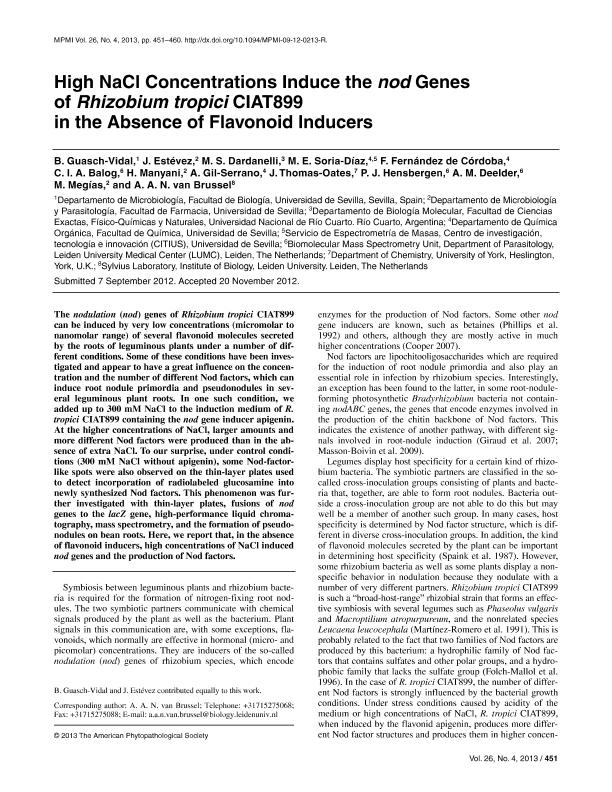Artículo
High NaCl Concentrations Induce the nod Genes of Rhizobium tropici CIAT899 in the Absence of Flavonoid Inducers
Guasch Vidal, B.; Estévez, J.; Dardanelli, Marta Susana ; Soria Díaz, M. E.; Fernández de Córdoba, F.; Balog, C. I. A.; Manyani, H.; Gil Serrano, A.; Thomas Oates, J.; Hensbergen, P. J.; Deelder, A. M.; Megías, M.; Brussel, A. A. N. van
; Soria Díaz, M. E.; Fernández de Córdoba, F.; Balog, C. I. A.; Manyani, H.; Gil Serrano, A.; Thomas Oates, J.; Hensbergen, P. J.; Deelder, A. M.; Megías, M.; Brussel, A. A. N. van
 ; Soria Díaz, M. E.; Fernández de Córdoba, F.; Balog, C. I. A.; Manyani, H.; Gil Serrano, A.; Thomas Oates, J.; Hensbergen, P. J.; Deelder, A. M.; Megías, M.; Brussel, A. A. N. van
; Soria Díaz, M. E.; Fernández de Córdoba, F.; Balog, C. I. A.; Manyani, H.; Gil Serrano, A.; Thomas Oates, J.; Hensbergen, P. J.; Deelder, A. M.; Megías, M.; Brussel, A. A. N. van
Fecha de publicación:
04/2013
Editorial:
American Phytopathological Society
Revista:
Molecular Plant-Microbe Interactions
ISSN:
0894-0282
Idioma:
Inglés
Tipo de recurso:
Artículo publicado
Resumen
The nodulation (nod) genes of Rhizobium tropici CIAT899 can be induced by very low concentrations (micromolar to nanomolar range) of several flavonoid molecules secreted by the roots of leguminous plants under a number of different conditions. Some of these conditions have been investigated and appear to have a great influence on the concentration and the number of different Nod factors, which can induce root nodule primordia and pseudonodules in several leguminous plant roots. In one such condition, we added up to 300 mM NaCl to the induction medium of R. tropici CIAT899 containing the nod gene inducer apigenin. At the higher concentrations of NaCl, larger amounts and more different Nod factors were produced than in the absence of extra NaCl. To our surprise, under control conditions (300 mM NaCl without apigenin), some Nod-factor-like spots were also observed on the thin-layer plates used to detect incorporation of radiolabeled glucosamine into newly synthesized Nod factors. This phenomenon was further investigated with thin-layer plates, fusions of nod genes to the lacZ gene, high-performance liquid chromatography, mass spectrometry, and the formation of pseudonodules on bean roots. Here, we report that, in the absence of flavonoid inducers, high concentrations of NaCl induced nod genes and the production of Nod factors.
Palabras clave:
Phaseolus Vulgaris
,
Rhizobium
,
Stress
,
Nod Factor
Archivos asociados
Licencia
Identificadores
Colecciones
Articulos(CCT - CORDOBA)
Articulos de CTRO.CIENTIFICO TECNOL.CONICET - CORDOBA
Articulos de CTRO.CIENTIFICO TECNOL.CONICET - CORDOBA
Citación
Guasch Vidal, B.; Estévez, J.; Dardanelli, Marta Susana; Soria Díaz, M. E.; Fernández de Córdoba, F.; et al.; High NaCl Concentrations Induce the nod Genes of Rhizobium tropici CIAT899 in the Absence of Flavonoid Inducers; American Phytopathological Society; Molecular Plant-Microbe Interactions; 26; 4; 4-2013; 451-460
Compartir
Altmétricas



